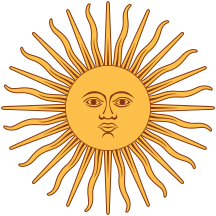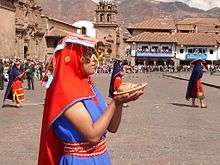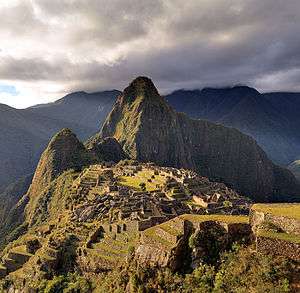Religion in the Inca Empire
In the heterogeneous Inca Empire, polytheistic religions were practiced. Some deities, such as Pachamama and Viracocha, were known through throughout the empire, while others were localized.
Deities

Inca deities occupied the three realms:
- hanan pacha, the celestial realm in the sky.
- ukhu pacha, the inner earth realm.
- kay pacha, the outer earth realm, where humans live.
Ukhu pacha was the domain of Pachamama, the Earth mother, who is universal to Andean mythologies. Kanopa was the God of Pregnancy.
Con-Tici Viracocha Pachayachachic, the first god, creator of the three realms and their inhabitants, was also the father of Inti.
Origin
Many ancient Andean peoples traced their origins to ancestral deities. Multiple clans could share similar ancestral origins. The Inca claimed descent from the Sun and the Moon, their Father and Mother. Many clans claimed descent from early proto-humans that emerged from local sites in nature called pacarinas.
The earliest ancestors of the Inca were known as Ayar, the first of which was Manco Cápac or Ayar Manco. Inca mythology tells of his travels, in which he and the Ayar shaped and marked the land and introduced the cultivation of maize.
Religious expansion
Religious traditions in the Andes tended to vary among different ayllus. While the Inca generally allowed or even incorporated local deities and heroes of the ayllus they conquered, they did bring their gods to those peoples by incorporating them in law such as required sacrifice. The Inca attempted to combine their deities with conquered ones in ways that raised the status of their own. One example of this is Pachamama, the goddess of Earth, who was worshiped long before the rise of the Inca. In the Inca mythology Pachamama having been integrated was placed below the Moon who the Inca believed ruled over all female gods.[1]
Duality
A theme in Inca mythology is the duality of the Cosmos. The realms were separated into the upper and lower realms, the hanan pacha and the ukhu pacha and urin pacha. Hanan pacha, the upper world, consisted of the deities of the sun, moon, stars, rainbow, and lightning while ukhu pacha and urin pacha were the realms of Pachamama, the earth mother, and the ancestors and heroes of the Inca or other ayllus. Kay pacha, the realm of the outer earth, where humans resided was viewed as an intermediary realm between hanan pacha and ukhu pacha. The realms were represented by the condor (upper world), puma (outer earth) and snake (inner earth).
Sacred sites or things named wak'a were spread around the Inca Empire. In Andean mythology a wak'a was a deific entity which resided in natural objects such as mountains, boulders, streams, battle fields, other meeting places, and any type of place that was connected with past Incan rulers. A wak'a could also be an inanimate object such as pottery which was believed to be a deity-carrying vessel. Spiritual leaders in a community would use prayer and offerings to communicate with a wak'a for advice or assistance. Human sacrifice was part of Incan rituals in which they usually sacrificed a child (qhapaq hucha) or a slave. The Incan people thought it was an honor to die as an offering.
Archaeological remains confirm such human sacrificial practices, according to Reinhard and Ceruti: "Archaeological evidence found on distant mountain summits has established that the burial of offerings was a common practice among the Incas and that human sacrifice took place at several of the sites. The excellent preservation of the bodies and other material in the cold and dry environment of the high Andes provides revealing details about the rituals that were performed at these ceremonial complexes."[2]
Divination
The Incas also used divination. Divination was used to inform people in the city of social events, predict battle outcomes, and ask for metaphysical intervention.
Divination was an important part of Inca religion, as reflected in the following quote:
The native elements are more obvious in the case of the sunrise divination. Apachetas, coca and the sun were major elements in pre-Conquest religion, and divination, the worship of sacred mountains and the bringing retribution against enemies were important ritual practices.[3]:292–314
Festivals


The Inca calendar had 12 months of 30 days, with each month having its own festival, and a five-day feast at the end, before the new year began. The Incan year started in December, and began with Qhapaq Raymi, the magnificent festival.[4]
| Gregorian month | Inca month | Translation |
|---|---|---|
| January | Camay | Fasting and Penitence |
| February | Hatun-pucuy | Great Ripening |
| March | Pacha-puchuy | Earth Ripening |
| April | Ayrihua or Camay Inca Raymi | Festival of the Inca |
| May | Aymoray qu or Hatun Cuzqui | Harvesting |
| June | Inti Raymi | Feast of the Sun and the great festival in honour of the sun for the harvest |
| July | Chahua-huarquiz, Chacra Ricuichi or Chacra Cona | The Harvest Festival |
| August | Yapaquis, Chacra Ayaqui or Capac Siquis | Sowing month |
| September | Coya Raymi and Citua | Festival of the Moon |
| October | K'antaray or Uma Raymi | Month of crop watching |
| November | Ayamarca | Festival of the dead |
| December | Capac Raymi | Magnificent festival |
See also
- Inca Empire
- Inca mythology
- Inca cuisine
- Spanish conquest of the Inca Empire
- Huarochirí Manuscript
- Muisca religion
References
- ↑ Steele, Paul Richar d (2004). Handbook of World Mythology. ABC-CLIO. ISBN 978-1576073544.
- ↑ Reinhard, Johan; Ceruti, Constanza (2005). "Sacred Mountains, Ceremonial Sites, and Human Sacrifice Among the Incas". Archaeoastronomy: The Journal of Astronomy in Culture. 19: 2. ISSN 0190-9940.
- ↑ Rowe, John H. (1946). Julian H. Steward, ed. Handbook of South American Indians Vol. 2 The Andean Civilizations (PDF). Washington: Smithsonian Institution. pp. 183–330.
- ↑ Kendall, Ann (1989). Everyday life of the Incas. New York: Dorset Press. ISBN 9780880293501.
External links
- Inca Religion - Ancient History Encyclopedia
- "Inca Religion", Elliott Shaw (General Editor), Overview of World Religions, PHILTAR, University of Cumbria
